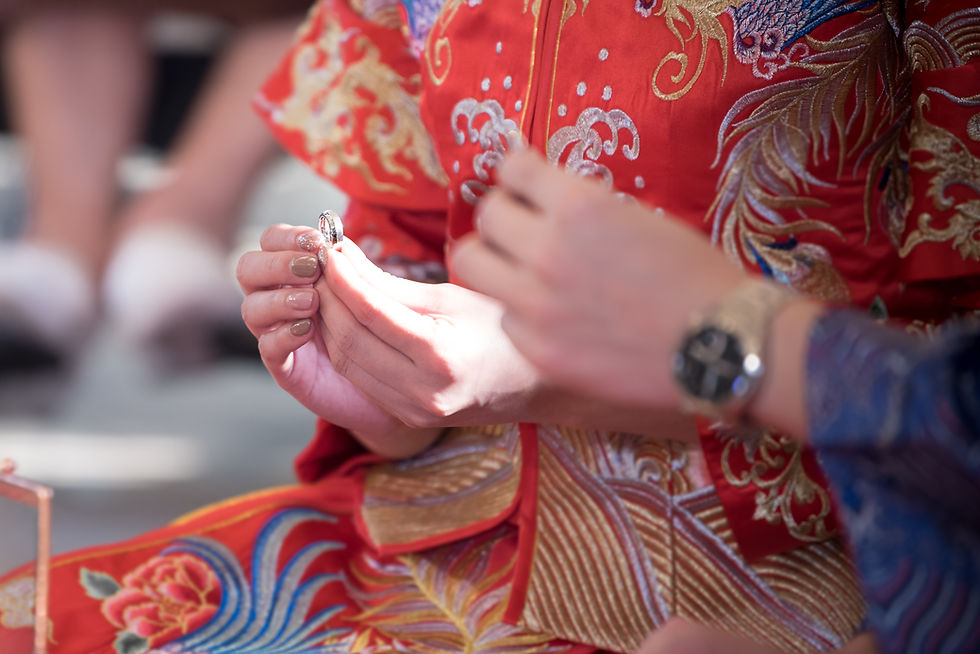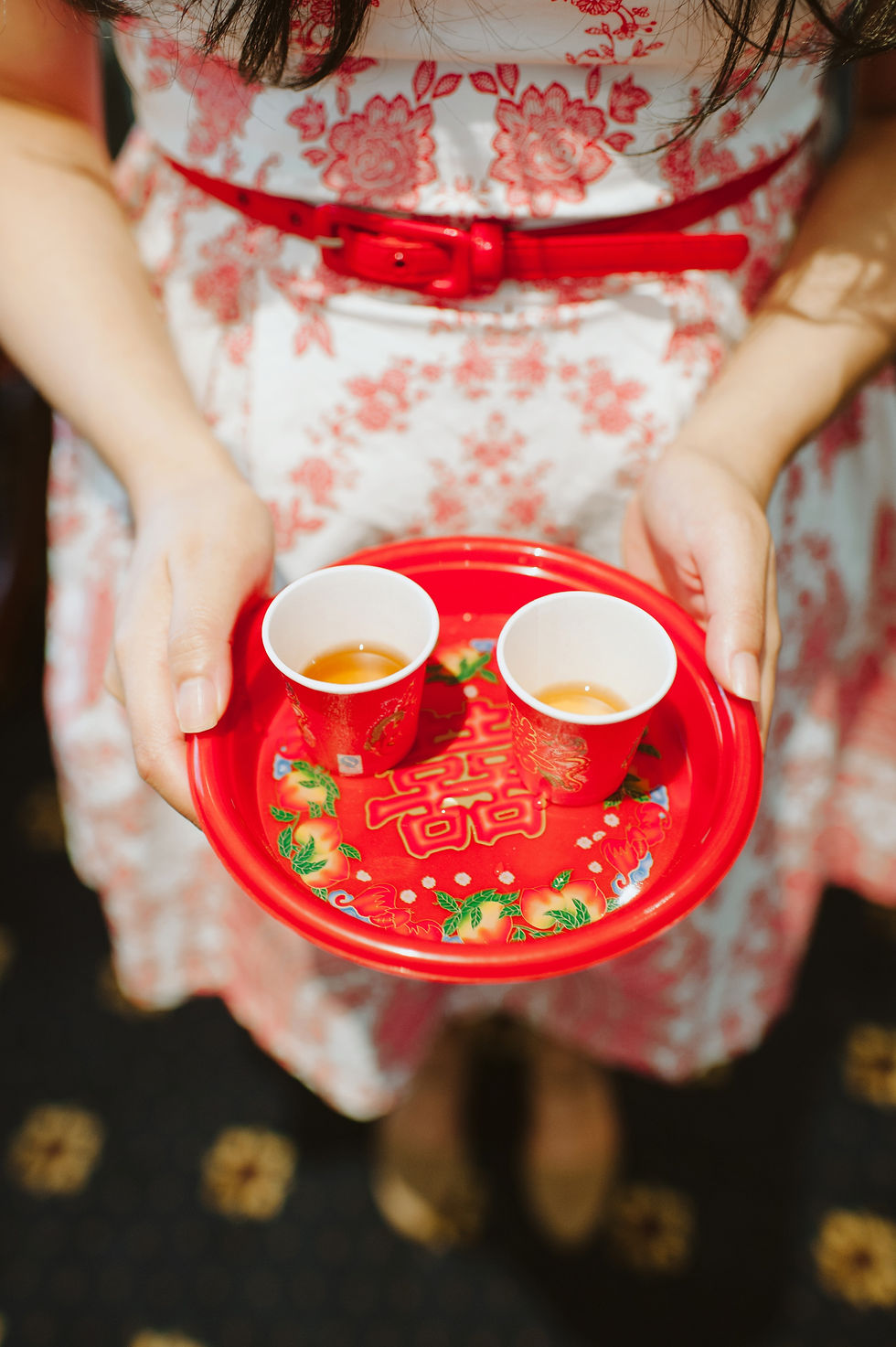A Modern Guide to Chinese Wedding Traditions
- Lovestills

- Jul 8, 2020
- 5 min read
When it comes to wedding planning, we tend to think of our dream dress, the wedding venue, photo shoot ideas, the honeymoon and not so much the traditional aspects. In fact, we tend to leave that in the good hands of our parents or in-laws, letting them decide what to do. But we thought, it would be nice if we helped to compile a simple modern guide for common Chinese wedding traditions.
So, if you are currently in the midst of your wedding planning, and looking to incorporate traditional Chinese customary rituals, we hope this guide will come in handy.
Common Chinese Wedding Traditions
• Picking an Auspicious Date
• Betrothal a.k.a Guo Da Li
• Dowry a.k.a Jia Zhuang
• Bed Setting a.k.a An Chuang
• Hair Combing a.k.a Shang Tou
• Tea Ceremony

Picking an Auspicious Date
Traditionally, the Chinese would seek out a fortune teller for selecting an auspicious date for the wedding. The idea is that it is such an important milestone in life, it should be done on a specially "lucky" day. It is "calculated" based on the couple's birth dates and times and referring to the Chinese calendar for good days.
For the modern bride, this might be a hassle as the selected date may not be a date you want or it might be tough to accommodate the venue or vendors you want. My personal experience? We spoke to a really nice fortune teller who understood we wanted to get married within the year, and months we wanted to avoid. She gave us a couple of options and luckily we found a date which worked for us.
Suggestion: If your parents or in laws don't require this, you can skip this step! Else if it required, you can let your fortune teller know your preferences - and hopefully they can find a date that works.
Betrothal
In the past, the betrothal was a huge affair in the Chinese pre-wedding process where the families of the bride and groom meet. The gifting from the groom's family to the bride's is a way to symbolize good luck, prosperity and also fertility for the new couple. Depending on the Chinese dialect group, the type of gifts may differ.
For the modern bride, there are many traditional Chinese customary shops and even online ones who offer packages of the "traditional" suite of gifts required to be presented to the bride's family. So it can be a fuss-free process. We chose to just get what was recommended by the shop (although we did tell them we preferred to leave out the less practical gifts) and settled our purchases all in less than an hour.
Dowry
In response to the betrothal, the bride's family would then reciprocally gift the couple with a dowry. This could be on the same day or separately on another day before the wedding day. The intention behind is similar, with various gifts symbolizing a variety of blessings for the couple. This would typically include: new bedding for the couple's new home, new clothing for the bride, tea sets (to be used during the wedding day tea ceremony) , tub with baby items, pairs of red clogs, candles and more...
For the modern bride, these items too can be easily procured in one sitting at a traditional Chinese customary shop. Some even have miniature versions, so they don't take up too much space in your new home.

Bed Setting
The idea behind bed-setting or an-chuang, is to pass on good luck, bless the couple with a loving marriage and fertility. The ritual involves the couple asking another couple (who they deem as being loving, have a good life and blessed with kids) to shower them with blessings by setting the bed. The bed is then decked out in bridal sheets of auspicious red color (or even pink). For some families, a pair of bedside lamps are lit to symbolize having sons in the family. And to finish the process, a plate with red dates, lotus seeds, longans etc. are placed on the bed to symbolize even more blessings. The bed is then left untouched until the actual wedding day.
On the actual day, some families also ask the little boys in the family to roll on the bridal bed to symbolize fertility and conceiving a boy.
For the modern bride, all of the following items can be similarly procured at the traditional Chinese customary shop, or even your neighborhood provisions shop if you know what to get. To placate our parents, we bought a set of cheap red bed sheets just for this purpose, and have not used it since.
Hair Combing Ceremony
This special ceremony is typically carried out on the night before the wedding day in the respective houses of the bride and groom. It involves the parents (or a relative) combing their children's hair as they recite verses to bless them - symbolizing a transition into a married adult.
Among the many traditions, this is one that we've noticed being adopted less by modern brides. Parents also don't seem too hung up on this particular tradition. Perhaps many brides have too many things on their minds on the day before the wedding? We don't know. But this is something I personally didn't include in my own wedding day as well.

Tea Ceremony on Wedding Day
The tea ceremony is an important custom in the wedding day where the bride and groom are formally introduced to the various members of the family on both sides. From the elders to the youngest, in order of seniority, the couple will serve tea to the elders and be served tea by the younger ones. They will use the tea set from the dowry.
For modern brides, the tea ceremony can be done at the respective homes with the immediate family. And should the family require, another round with the extended family if they were not present earlier in the day.
Interesting thing to note, the order of serving tea during the traditional tea ceremony is as follows:
Parents, Grandparents, Grand-uncles and grand-aunties (in order of seniority - eldest first), Uncles and aunties, Elder siblings, Elder cousins, Younger siblings (to serve bride & groom), Nieces and nephews (to serve bride & groom). Usually paternal relatives are served before their maternal ones - if they are all present at the venue. During the tea ceremony, the groom should be on the right with the bride on the left side. Female relatives should seat themselves across from the groom while male relatives are seated in front of the bride.
We hope this simple guide has been helpful to any brides or grooms planning to incorporate these Chinese customs in your wedding. Do feel free to share with your friends/family should you know of anyone who might need this guide during these times.




Comments